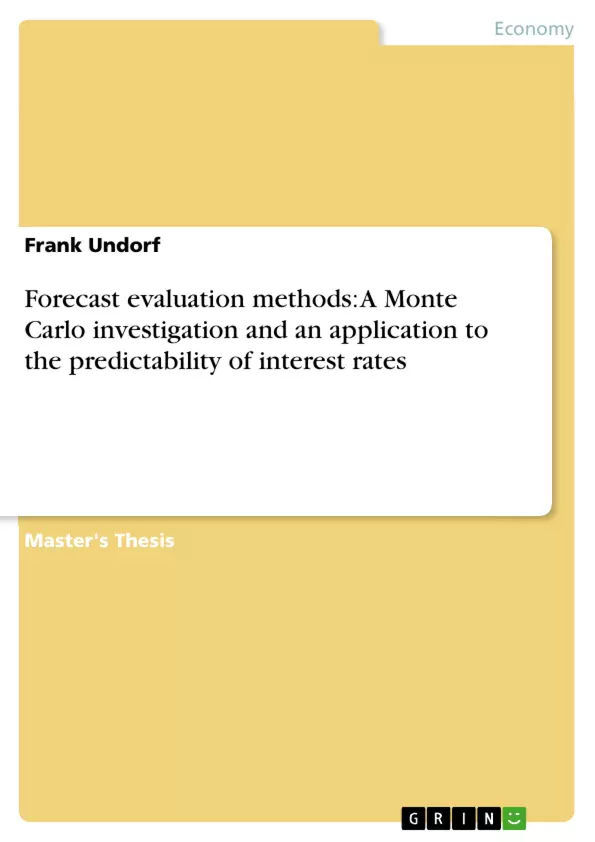This thesis overviews selected forecast evaluation tests and attempts to link the concept of testing equal mean squared error and forecast encompassing within a common simple regression framework. A Monte Carlo analysis provides size and power properties for both a model-free and model-based environment. In particular, the encompassing regression based test assessing the null hypothesis of equal mean squared error offers beneficial size and power properties compared to the Diebold-Mariano test, at least in a conditional homoskedastic small sample framework without autocorrelation. A simple application of several tests is provided by comparing different interest rate prediction models like a time series model, a linear model with macroeconomic indicators and a dynamic yield curve model. It turns out that simple time series specifications are hard to outperform for most of the comparisons. However, indicators like the German stock market index or the ifo expectation indicator provide useful information for future German government bond yields.
Inhaltsverzeichnis (Table of Contents)
- Introduction
- Forecast evaluation methods
- Selected tests in a model-free environment
- Forecast encompassing
- Equal mean squared error
- Selected tests in a model-based environment
- Exemplary forecasting framework
- Non-nested model structure
- Nested model structure
- Inference à la Giacomini and White (2006)
- Selected tests in a model-free environment
- Monte Carlo evidence
- Model-free framework
- Size properties
- Power properties
- Model-based framework
- Non-nested models
- Size investigation
- Power investigation
- Nested models
- Size investigation
- Power investigation
- Non-nested models
- Model-free framework
- Application: Predicting interest rates
- Competing prediction models
- Macro-indicator model
- Pure time series model
- Dynamic Svensson (1994) model
- Results of pairwise comparison
- Out-of-sample Granger causality
- Competing prediction models
Zielsetzung und Themenschwerpunkte (Objectives and Key Themes)
This thesis focuses on evaluating and comparing forecast series using different hypothesis tests. It aims to link the concepts of forecast encompassing and equal mean squared error (MSE) within a common regression framework. The research investigates the size and power properties of these tests in both model-free and model-based environments, particularly in small sample sizes. It also examines the predictive power of macroeconomic indicators for interest rates compared to simple time series models and dynamic yield curve models.
- Comparison of competing forecast series using hypothesis tests
- Linking forecast encompassing and equal mean squared error (MSE) concepts
- Investigating size and power properties of tests in model-free and model-based environments
- Examining the predictive power of macroeconomic indicators for interest rates
- Analyzing the performance of different interest rate forecasting models
Zusammenfassung der Kapitel (Chapter Summaries)
- Introduction: This chapter introduces the three main research objectives of the thesis. These objectives encompass a comprehensive overview of forecast evaluation tests, a Monte Carlo analysis of their properties, and an empirical application of the tests to interest rate forecasting models.
- Forecast evaluation methods: This chapter presents a selection of forecast evaluation tests, categorized by their evaluation criterion, model structure, and null hypothesis requirements. It specifically examines the relationship between forecast encompassing and testing equal mean squared error.
- Monte Carlo evidence: This chapter delves into the size and power properties of the selected tests using Monte Carlo simulations. It investigates the performance of the tests in both model-free and model-based environments, focusing on small sample sizes.
- Application: Predicting interest rates: This chapter applies the discussed tests to compare different interest rate forecasting models, including a macro-indicator model, a pure time series model, and a dynamic yield curve model. It analyzes the predictive power of macroeconomic indicators for interest rate maturities and forecast horizons.
Schlüsselwörter (Keywords)
This thesis focuses on forecast evaluation, hypothesis testing, forecast encompassing, equal mean squared error, Monte Carlo analysis, interest rate forecasting, macroeconomic indicators, time series models, and dynamic yield curve models.
- Quote paper
- Frank Undorf (Author), 2017, Forecast evaluation methods: A Monte Carlo investigation and an application to the predictability of interest rates, Munich, GRIN Verlag, https://www.grin.com/document/439428



